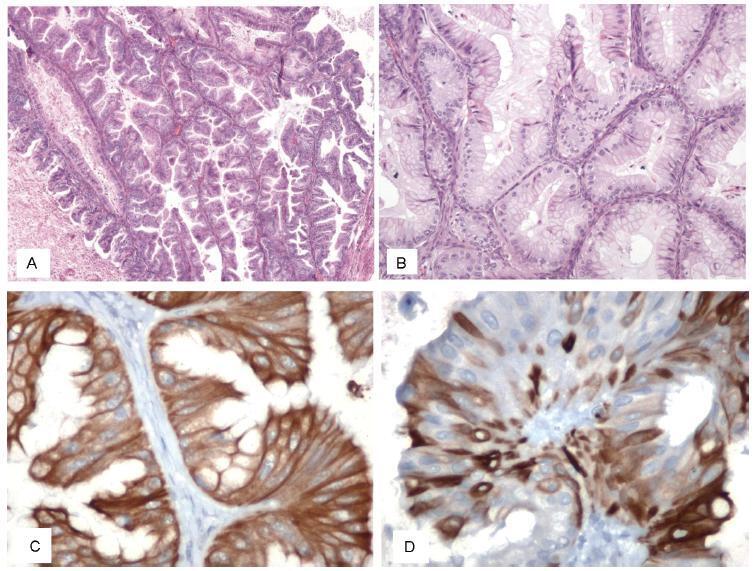Summary
Revista Brasileira de Ginecologia e Obstetrícia. 2008;30(10):511-517
DOI 10.1590/S0100-72032008001000006
PURPOSE: to correlate the clinical manifestations of patients with amenorrhea and X chromosome abnormalities. METHODS: a retrospective analysis of the clinical and laboratorial findings of patients with amenorrhea and abnormalities of X chromosome, attended between January 1975 and November 2007 was performed. Their anthropometric measures were evaluated through standard growth tables, and, when present, minor and major anomalies were noted. The chromosomal study was performed through the GTG banded karyotype. RESULTS: from the total of 141 patients with amenorrhea, 16% presented numerical and 13% structural abnormalities of X chromosome. From these patients with X chromosome abnormalities (n=41), 35 had a complete clinical description. All presented hypergonadotrophic hypogonadism. Primary amenorrhea was observed in 24 patients, 91.7% of them with a Turner syndrome phenotype. Despite a case with Xq22-q28 deletion, all patients with this phenotype presented alterations involving Xp (one case with an additional cell lineage 46,XY). The two remaining patients with only primary amenorrhea had proximal deletions of Xq. Among the 11 patients with secondary amenorrhea, 54.5% presented a Turner phenotype (all with isolated or mosaic X chromosome monosomy). Patients with phenotype of isolated ovarian failure had only Xq deletions and X trisomy. CONCLUSIONS: the cytogenetic analysis must always be performed in women with ovarian failure of unknown cause, even in the absence of clinical dysmorphic features. This analysis is also extremely relevant in syndromic patients, because it can either confirm the diagnosis or identify patients in risk, like the cases involving a 46,XY lineage.
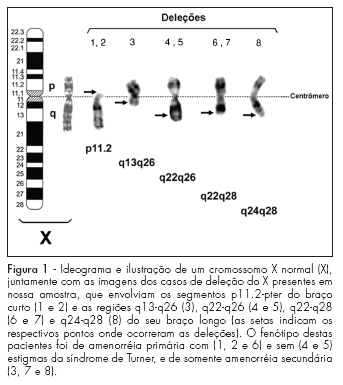
Summary
Revista Brasileira de Ginecologia e Obstetrícia. 2015;37(11):512-515
DOI 10.1590/SO100-720320150005434
To assess the chemotactic activity and phagocytic response of neutrophilic polymorphonuclear leukocytes among women in the first five days postpartum.
A prospective, cross-sectional clinical-laboratory study was conducted. Data of 31 postpartum women during the first five days after vaginal delivery were compared with those of 24 healthy non-pregnant non-postpartum women matched for age. The inclusion criteria were postpartum, clinically and obstetrically healthy women; vaginal delivery, singleton pregnancy carried to term; non-hypertensive, hyperglycemic, allergic, malnourished or with autoimmune or neoplastic diseases; not having received vaccines or blood products in the last three months. The Control Group was chosen according to the same inclusion criteria but involving non-pregnant non-postpartum women. The chemotactic activity of neutrophilic polymorphonuclear leukocytes was assessed by determining the distance from directed migration to bacterial lipopolysaccharide, in three Boyden chamber assays. The phagocytic response was identified by assessing the Zymosan particles' ingestion in three assays carried out in Leighton tubes. The Student's t- test was used in the statistical analysis, adopting a 5% level of significance.
The chemotactic activity of neutrophilic polymorphonuclear leukocytes from postpartum women in the presence of homologous (73.2±6.9) and autologous (78.6±13.9) sera showed a significant increase compared to the values observed in the Control Group (64.1±4.1 and 66.6±5.4). Both chemotactic response and phagocytosis ingestion phase of neutrophilic polymorphonuclear leukocytes were significantly increased (p<0.05) in postpartum women compared to healthy non-pregnant and non-postpartum women.
There was an increase in the chemotactic activity and phagocytic response of neutrophilic polymorphonuclear leukocytes during the first five days after vaginal delivery in women.
Summary
Revista Brasileira de Ginecologia e Obstetrícia. 2016;38(10):512-517
Triple-negative breast carcinomas (TNBCs) represent a heterogeneous group of neoplasias, even though they generally exhibit a clinically more aggressive phenotype, and are more prevalent in young women. To date, targeted therapies for this group of tumors have not been defined. The aim of this study was to evaluate the frequency of the apocrine subtype in TBNCs from premenopausal patients as defined by the immunohistochemical expression of the androgen receptor (AR) and its association with: histological type; tumor grade; proliferative activity; epidermal growth factor receptor (EGFR) expression; and a basal-like phenotype.
A total of 118 tumor samples from patients aged 45 years or younger were selected and reviewed according to histological type and grade. Ki-67 expression was also evaluated. Immunohistochemical expression of the AR, basal cytokeratin ⅚, and EGFR expression were analyzed in tissue microarrays. The apocrine subset was defined by AR-positive expression. The basal-like phenotype was characterized by cytokeratin ⅚ and/or EGFR expression.
An apocrine profile was identified in 6/118 (5.1%) cases. This subset of cases also exhibited a lower rate of Ki-67 expression (17.5% versus 70.0%, p= 0.02), and a trend toward a lower histological grade (66.7% versus 27.9%, p= 0.06).
The apocrine subtype of TNBCs is rare among premenopausal women, and it tends to present as carcinomas of lower grade and lower proliferative activity, suggesting a less aggressive biological phenotype.
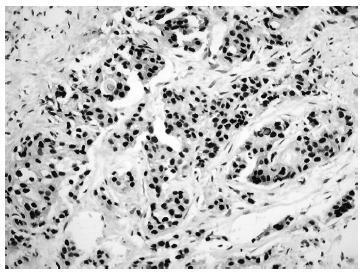
Summary
Revista Brasileira de Ginecologia e Obstetrícia. 2006;28(9):513-522
DOI 10.1590/S0100-72032006000900003
PURPOSE: to describe, in participants of the Brazilian Study of Gestational Diabetes (EBDG), the percentile distribution of uterine height by gestational age and to validate the use of percentiles of the chart derived by the "Centro Latino-Americano de Perinatologia" (CLAP), used as reference in predicting abnormal fetal growth. METHODS: the EBDG is a cohort study of 5564 pregnant women older than 19 years, followed through and after delivery. Interviews and standardized anthropometry were performed at baseline between 20-28 weeks. Medical records covering prenatal and delivery periods were then reviewed following a standardized approach. Analyses pertain to 3539 women with gestational age confirmed by ultrasound. Diagnostic properties of the 10th and the 90th percentiles of both charts (EBDG and CLAP) as predictors of abnormal neonatal weight were determined. RESULTS: uterine height was higher in EBDG than in the CLAP chart at every gestational week, being 1-4 and 2-6 cm greater, at the 10th and 90th percentiles respectively. The CLAP 10th percentile classified as small the uterine heights of only 0.3 to 1.7% of Brazilian women, while the 90th percentile classified as large the uterine heights of 42 to 57% of the sample. The sensitivity of CLAP percentile 10 in the prediction of small for gestational age varied from 0.8 to 6% and the specificity of CLAP percentile 90 in the prediction of large for gestational age, from 46 to 61%. CONCLUSIONS: the CLAP uterine height reference chart does not reflect the current uterine growth pattern of pregnant Brazilians, limiting its clinical applicability in the detection of abnormal fetal growth, especially intrauterine growth restriction.
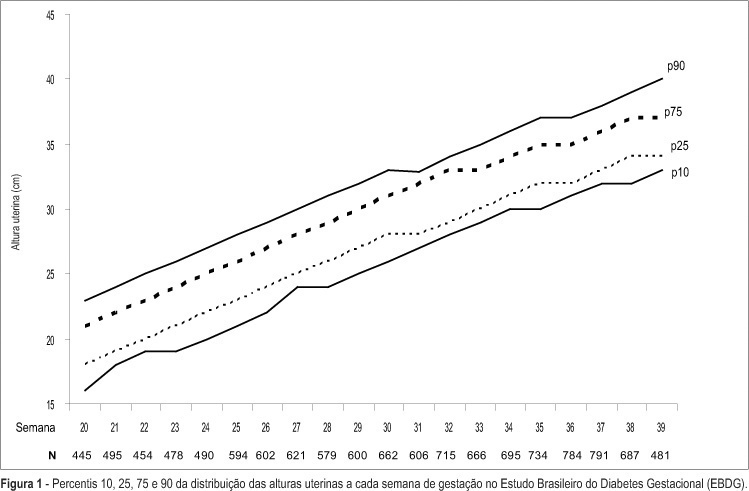
Summary
Revista Brasileira de Ginecologia e Obstetrícia. 2003;25(7):513-516
DOI 10.1590/S0100-72032003000700008
PURPOSE: to evaluate the usefulness of the in vitro maturation technique of human oocyte and subsequent fertilization. METHODS: this is a prospective nonrandomized, descriptive study, carried out during the period of November 1999 to March 2001, with 20 cycles of in vitro fertilization of 15 patients with tubal infertility. All signed the written informed consent before the beginning of the study. The selected patients were at least 18 and at most 32 years of age, with only tubal infertility, and body mass index less than 25 kg/m². The patients received 300 UI of recombinant follicle stimulating hormone (FSH) by intramuscular injection at the second day of the cycle and additional doses of 150 IU at the fourth and sixth days of cycle. The oocyte retrieval was performed at the seventh day of the cycle. Those oocytes classified as immature were cultured in tissue culture medium 199 (TCM-199) with antibiotics, pyruvate, FSH, human chorionic gonadotropin (hCG) and serum (serum substitute supplement - Irvine Scientific®). After 48 h of culture, the oocytes that achieved metaphase II stage were inseminated, and the fertilized ones were transferred. RESULTS: one hundred and forty-four follicles were aspirated. There were 67 (46.5%) immature retrieved oocytes and 43 (64.2%) reached the metaphase II stage and were inseminated. Thirty fertilized oocytes and 25 embryos were transferred to 10 patients. There was one pregnancy with a baby born. CONCLUSION: we conclude that to mature human oocytes in vitro before in vitro fertilization is a procedure able to achieve pregnancy.
Summary
Revista Brasileira de Ginecologia e Obstetrícia. 2021;43(7):513-521
Early marriage has many deleterious effects on the health of girls, such as sexual dissatisfaction, an inevitable result of the lack of sufficient knowledge about sexual issues at the time of the marriage. The goal of the present study was to determine the effectiveness of counseling based on functional analytic psychotherapy with enhanced cognitive therapy (FECT) on the sexual quality of life of married adolescent women.
This clinical trial was conducted between July and October 2019 on 150 married adolescent women who met the inclusion criteria. In the intervention group, FECTwas conducted in sixteen 90-minute sessions twice a week. The Sexual Quality of Life-Female (SQOL-F) questionnaire was used. When the study ended, the control group was given the choice of receiving the same intervention as the intervention group.
The paired t-test showed a significant difference between the mean score of sexual quality of life before (52.33±23.09) and after (88.08±10.51) counseling in the intervention group (p<0.0001). According to the analysis of covariance, there was a significant difference between the score on sexual quality after counseling between the intervention (88.08±10.51) and control (60.32±23.73) groups (p<0.0001). There was also a significant difference between the mean score on the four dimensions of sexual quality of life in the intervention group (p<0.0001).
The results showed that counseling based on FECT improved the sexual quality of life in all dimensions in married adolescent women.
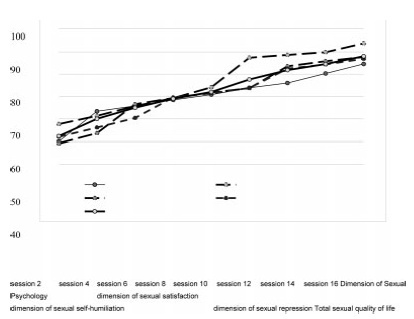
Summary
Revista Brasileira de Ginecologia e Obstetrícia. 2018;40(9):513-517
Induction of labor (IL) is a common obstetric procedure, but it is questionable whether or not it results in higher cesarean section (CS) rates. The present study aims to evaluate the impact of IL in the overall CS rates and to analyze these rates according to the method of IL employed and to the Robson group in which it was applied.
We have conducted a retrospective study including pregnant women whose labor was induced at a tertiary hospital in 2015 and 2016. All women were classified according to the Robson Classification System (RCS). The CS rates were analyzed and compared regarding the method of IL employed.
A total of 1,166 cases were included. The CS rate after IL was 20.9%, which represented 23.1% of the total of CSs performed in 2015 and 2016. The highest CS rates were recorded in RCS groups 5 (65.2%) and 8 (32.3%). Group 2 was the highest contributor to the overall CS rate, since it represented 56.7% of the population. The intravaginal prostaglandins method was the most used (77%). Transcervical Foley catheter was the preferredmethod in group 5 and intravaginal prostaglandins in all the other groups. The CS rate was higher when transcervical Foley catheter was used (34.1%).
Transcervical Foley catheter induction was associated with a higher rate of CS, probably because it was the preferred method used in group 5.
Summary
Revista Brasileira de Ginecologia e Obstetrícia. 2017;39(9):513-515
Acute abdomen secondary to epithelial ovarian cancer rupture during pregnancy is a rare event. Our aim is to present how the work of a coordinated multidisciplinary team in a case of ruptured epithelial ovarian cancer during pregnancy is feasible to obtain the best results possible. A 34-year-old woman during the 37th week of her first gestation presented with an acute abdomen. During laparotomy, a ruptured 16.5-cm left ovarian tumor was detected; the tumor was extirpated and sent to pathologic evaluation. In the meantime, a Kerr cesarean section was performed, and a healthy female neonate was born. The tumor was diagnosed as a cystadenocarcinoma; therefore, the family and the combined surgical team (obstetricians and a surgical oncologist) decided to complete a definitive radical ovarian cancer surgery: hysterectomy, right salpingooophorectomy, lymphadenectomy, omentectomy and appendectomy. The patient’s postoperative evolution was uneventful, and she was sent to adjuvant chemotherapy.
